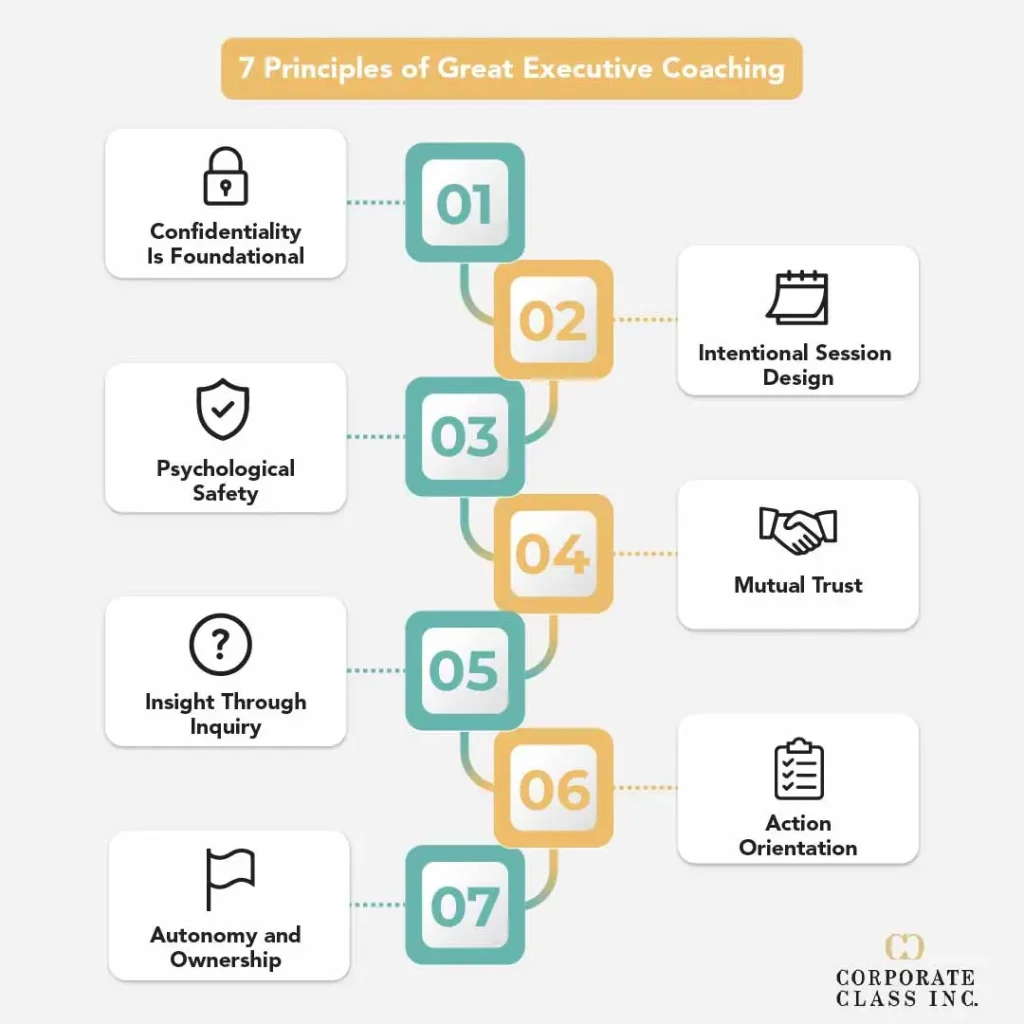Executive coaching shapes leaders by providing structured guidance, honest feedback, and measurable results. It works as a partnership where executives gain clarity, sharpen decision-making, and align performance with organizational goals. In this article, you will see how executive coaching works, the seven principles that set it apart, and why applying them drives long-term leadership impact.
Key Takeaways
- Executive coaching builds measurable leadership growth through structured sessions and actionable outcomes.
- Seven guiding principles define great executive coaching, from confidentiality to ownership.
- Applying these principles ensures stronger trust, better results, and sustainable leadership independence.
How Executive Coaching Works?
Executive coaching is a structured process where an experienced coach partners with an executive to identify challenges and set clear goals. Sessions are designed to provide both accountability and support, giving leaders a space to explore decisions that affect strategy and performance. Unlike training, it focuses on personal growth tied directly to business outcomes.
The process begins with assessments, stakeholder interviews, and alignment on key objectives. These tools help define measurable targets, such as improving communication, refining decision-making, or increasing team engagement. From there, sessions move into focused discussions that combine reflection, feedback, and practical application.
During ongoing sessions, coaching creates a cycle of learning, practicing, and refining. Executives gain new perspectives and test strategies in real situations, then return to evaluate what worked. This approach ensures progress is tracked, aligned with organizational goals, and anchored in real business results.
According to the International Coaching Federation, 86% of companies report they recouped their investment in coaching, and many saw an ROI several times over. That level of return comes from a process designed to connect leadership development directly to performance.
Measuring ROI in Executive Coaching
Executives and organizations alike want to see clear returns on their investment in coaching. Measuring ROI begins with setting defined outcomes at the start, such as improved decision-making speed, stronger team alignment, or revenue growth tied to leadership actions. Data from follow-up assessments, performance metrics, and employee engagement surveys provide tangible proof that coaching is working.
For many organizations, ROI is seen not only in numbers but also in qualitative improvements: higher confidence among leaders, a stronger culture, and reduced turnover. By tracking both, companies ensure their coaching programs align with long-term strategic goals.
7 Principles That Set Great Executive Coaching Apart

Our coaching engagement model is anchored in seven pillars that ensure every interaction delivers value, consistency, and measurable growth. These pillars form the backbone of our approach, shaping how sessions are designed, how trust is built, and how results are achieved. Together, they turn coaching from a conversation into a high-impact leadership system that drives sustainable performance.
1. Confidentiality Is Foundational
Confidentiality is the first, non-negotiable pillar. Clients are assured of complete discretion and privacy at every stage of the process. This commitment allows executives to discuss ambitions, challenges, and vulnerabilities without hesitation.
When leaders feel safe, they open up fully. That openness creates opportunities to address real issues rather than surface-level concerns. By protecting this trust, coaching becomes a powerful space for transformation where honest dialogue leads to stronger results.
2. Intentional Session Design
A strong coaching engagement is not left to chance, it is carefully structured. Each session begins with a clear agreement that aligns both coach and client on objectives and outcomes. This intentional design ensures that every conversation is purposeful, time-efficient, and results-oriented.
Consider the alternative: an unstructured session that drifts without direction. It may feel productive in the moment, but it rarely produces sustainable growth. With intentional design, sessions move leaders forward with measurable steps, recorded commitments, and accountability for follow-through.
- Set objectives at the start of every session
- Review commitments from the previous session
- Conclude with clear action items tied to organizational outcomes
3. Psychological Safety
No leader thrives in an environment filled with fear or second-guessing. Coaching must foster psychological safety, a respectful space where clients can explore ideas, test strategies, and share missteps without judgment. This sense of safety allows executives to push boundaries, experiment, and stretch their capabilities.
The impact of safety on performance is undeniable. Leaders who feel secure are more willing to challenge their own thinking, receive feedback, and embrace bold strategies. When safety and accountability come together, growth accelerates, and performance rises.
4. Mutual Trust
Mutual trust is the pillar that keeps the entire coaching engagement steady. The relationship between coach and client must be a partnership built on transparency, empathy, and respect. When trust is present, feedback is not only accepted but acted upon.
This trust does not stop at the coaching table. Leaders who experience it often replicate the practice in their organizations, creating teams where accountability and reliability are standard. In this way, trust established in coaching cascades through the culture, multiplying the value far beyond one executive.
5. Insight Through Inquiry
One of the hallmarks of powerful coaching is inquiry. Instead of providing answers, skilled coaches ask targeted, often challenging questions that reveal blind spots and unlock insight. These questions shift perspectives and open doors to breakthroughs that would remain hidden without inquiry.
For example: “If your team had complete confidence in you tomorrow, what would they do differently?” Questions like this do not simply spark conversation, they spark clarity. Through inquiry, leaders discover new approaches that drive measurable change.
6. Action Orientation
Insight is valuable, but progress only happens when it turns into action. That is why action orientation is at the core of our coaching model. Each session translates reflection into practical commitments that leaders can apply in real-world scenarios.
These actions may involve leading a difficult conversation, shifting a strategy, or testing a new leadership approach. Whatever the step, it becomes a deliverable that can be tracked, measured, and evaluated. Without action, coaching remains abstract. With it, coaching drives tangible business results.
7. Autonomy and Ownership
The ultimate goal of coaching is not dependency but independence. Leaders should complete a coaching engagement with the confidence and tools to guide themselves and their organizations effectively. This autonomy is what makes coaching sustainable long after formal sessions end.
Ownership empowers executives to take charge of their growth journey. They build resilience, adaptability, and decision-making strength without requiring constant external guidance. When coaching achieves this level of independence, it proves its true long-term value.
Vision-setting isn’t a buzzword. It’s how you lead with intention. Growth-minded executives use vision-setting to align their actions with long-term outcomes. It’s the difference between reacting and directing.
A company without vision is like a ship without a compass; drifting from wave to wave, hoping momentum turns into direction. That rarely happens. If you lead a business, your responsibility isn’t only to respond to the day-to-day. It’s to decide where you’re going and how your team gets there. Vision-setting helps you draw that map, prioritize that destination, and mobilize others toward it.
This article breaks down how growth-minded executives approach vision-setting. You’ll learn how to create structure around your core values, set layered goals, and lead with clarity. Vision is not reserved for idealists. It’s a performance tool, and when done right, it turns leadership into forward motion.
Key Takeaways
- Vision-setting aligns leadership actions with measurable long-term business growth.
- Executives translate values into layered goals across teams and timeframes.
- Effective vision-setting demands clarity, adaptability, and relentless communication.
Key Elements of Vision-Setting for Growth-Minded Executives
Vision-setting has structure. Growth-minded executives do not just visualize a better future, they engineer it. That process relies on specific leadership behaviours and tactical building blocks.
Clarity of Purpose
Start with clarity. If your team doesn’t understand the “why”, they’ll struggle with the “how”. Clarity defines direction, reduces friction, and energizes performance.
Every objective you set should tie back to your core purpose. That doesn’t mean simplifying goals. It means refining the message until everyone knows why the work matters. A clear purpose drives focused action.
Alignment with Core Values
Growth that contradicts your values creates cultural friction. Alignment ensures that as you scale, you remain authentic. That alignment shows up in your brand, customer relationships, and internal dynamics.
A well-set vision echoes your values across every initiative. It’s visible in how you innovate, expand, and hire. People follow leaders who act with integrity. That begins with staying aligned.
Ambitious but Achievable Goals
Did you know? Businesses that commit to written goals are 42% more likely to achieve them. Goals should inspire, not intimidate. Stretch targets are useful only when people believe they can reach them with effort and focus.
Executives who lead with ambition must also provide frameworks. Clear expectations, tools, and timelines turn high expectations into real progress. Ambition succeeds when it’s structured.
Inspiration and Motivation
Vision-setting is part inspiration. People want to feel part of something important. When your vision communicates meaning, energy follows.
Motivation doesn’t have to be loud. It has to be real. Teams engage when they see a future worth working toward. Leaders fuel that with consistent encouragement and demonstrated belief.
Adaptability
Great visions are steady in direction and flexible in execution. The marketplace will shift. New tools, people, and realities will challenge your initial assumptions. That doesn’t mean changing the vision, it means adjusting the plan.
Adaptable leaders review their goals frequently. They stay responsive, not reactive. They ask better questions, listen to frontline insights, and keep strategy relevant. That agility protects momentum.
Effective Communication
A great vision doesn’t travel on its own. You need to deliver it, often, clearly, and through multiple formats. From presentations to casual conversations, your team should hear the vision repeatedly and consistently.
Your communication strategy should include visual tools, written language, and spoken messages. Repetition creates recall. Recall drives alignment. You lead through what you say, and how often you say it.
How Growth-Minded Executives Think
Integrating Executive Coaching into Organizational Strategy
Coaching is most effective when it is not treated as a standalone initiative but integrated into broader leadership and organizational strategy. This means aligning coaching goals with company priorities such as succession planning, innovation, or market expansion. By connecting individual growth to organizational outcomes, coaching has a multiplier effect.
Leaders who experience coaching often apply what they learn directly to team development. This creates a cascading impact where improved leadership behaviours influence company culture and overall performance. Organizations that weave coaching into their strategy see stronger retention of talent and better alignment across all levels of leadership.
7 Skills You Develop Through Executive Coaching
Executive coaching is not limited to solving immediate challenges; it builds a portfolio of skills that leaders carry forward into every role and decision. These skills go beyond technical expertise and shape the way executives influence, communicate, and deliver results. By developing them through structured coaching, leaders strengthen their ability to perform under pressure, inspire teams, and deliver consistent business impact.
1. Strategic Thinking
One of the most powerful outcomes of executive coaching is the ability to think strategically. Instead of being consumed by day-to-day fires, you learn to see connections between current actions and future outcomes. This shift gives you the clarity to guide your organization with foresight rather than reaction.
- Coaches help leaders step back from daily pressures to see the bigger picture.
- You learn to evaluate opportunities, anticipate risks, and connect actions to long-term goals.
- Strategic thinking makes leaders less reactive and more proactive in guiding their organizations.
2. Communication Mastery
Leadership success often depends on how well you communicate. Coaching strengthens both the delivery and reception sides of communication, making sure your messages are clear and your listening is active. When leaders master communication, they reduce friction and build stronger alignment across teams.
- Coaching sharpens how you present ideas clearly and persuasively.
- You practice active listening, building credibility and trust with teams and stakeholders.
- Strong communication reduces conflict and improves collaboration across the organization.
3. Decision-Making Under Pressure
Executives are frequently required to make high-stakes decisions with incomplete information. Coaching helps you practice decision-making frameworks that balance logic with intuition. The result is confidence in your choices and speed in execution, even when the pressure is high.
- Through guided reflection, you strengthen the ability to make confident choices in high-stakes environments.
- Coaches help you balance data-driven analysis with intuition.
- This skill ensures leaders act quickly while still aligning with organizational priorities.
4. Emotional Intelligence
Emotional intelligence sits at the core of effective leadership. Executive coaching increases self-awareness, helping you understand how your emotions influence your decisions and interactions. With stronger empathy and composure, you can create a more stable and motivated work environment.
- Executive coaching emphasizes awareness of your own triggers and responses.
- You build empathy for how others experience your leadership style.
- High emotional intelligence allows you to motivate teams and handle conflict with composure.
5. Accountability and Discipline
Accountability ensures leaders follow through on commitments, while discipline sustains consistency in execution. Coaching puts systems in place that encourage both, making accountability a natural part of leadership. Over time, this creates credibility, reliability, and higher trust within your organization.
- Coaching establishes regular checkpoints that build accountability into your leadership style.
- You learn to hold yourself and others responsible for commitments.
- This discipline strengthens execution and improves organizational reliability.
6. Delegation and Empowerment
Many executives struggle with letting go of tasks, leading to burnout and bottlenecks. Coaching helps you reframe delegation as an opportunity to build capability in your team. When done effectively, it frees you for strategic priorities and empowers others to step into leadership responsibilities.
- Leaders often struggle with trying to do everything themselves.
- Coaches teach you to delegate effectively, freeing time for higher-level priorities.
- Empowering others creates stronger teams and reduces executive burnout.
7. Resilience and Adaptability
The business environment constantly shifts, and leaders who cannot adapt risk falling behind. Executive coaching develops resilience, allowing you to recover quickly from setbacks and keep teams motivated. With adaptability, you learn to navigate change with confidence and turn challenges into opportunities.
- Through coaching, you learn how to recover from setbacks and stay steady under uncertainty.
- Adaptability allows you to pivot strategies when markets, teams, or external forces shift.
- Resilient leaders model strength, encouraging their organizations to move forward with confidence.
FAQ
What is the main purpose of executive coaching?
The primary purpose of executive coaching is to drive measurable improvement in leadership capability and organizational performance. It is not simply about giving advice; it’s about helping leaders clarify goals, challenge limiting beliefs, and take deliberate action that translates into business impact.
For example, executives often enter coaching to improve communication, decision-making, or influence. Through structured sessions, they develop practical strategies they can apply immediately. Over time, coaching delivers benefits such as stronger employee engagement, higher productivity, and sharper strategic thinking.
How long does executive coaching usually take?
The length of executive coaching engagements varies depending on goals and context, but most programs last between six months and a year. This timeframe allows enough sessions to identify blind spots, practice new behaviours, and measure progress in real work situations.
Shorter engagements may address immediate challenges, such as preparing for a promotion or managing a high-stakes project. Longer engagements are often used for senior leaders who want to shift culture, improve cross-functional collaboration, or prepare successors for advanced roles. What matters most is that the duration aligns with the objectives set at the start.
Who benefits most from executive coaching?
Executive coaching benefits a wide range of leaders, though some groups see the greatest impact. Senior executives and C-suite leaders often turn to coaching when they need a confidential sounding board to refine strategy and manage organizational pressure. High-potential managers benefit by accelerating their readiness for larger roles and avoiding common leadership missteps.
Organizations also benefit because coaching strengthens retention and builds leadership pipelines. A report by the Human Capital Institute found that companies with strong coaching cultures have higher employee engagement and stronger business performance, making coaching valuable for both individuals and the enterprise.
Driving Growth Through Executive Coaching
Executive coaching delivers results when leaders commit to applying the principles consistently. Confidentiality, trust, structured sessions, and action-focused outcomes create a framework for measurable success. As you apply these practices, you build sustainable independence and stronger business performance. Take the next step and turn coaching into a leadership system that drives growth for years ahead.





